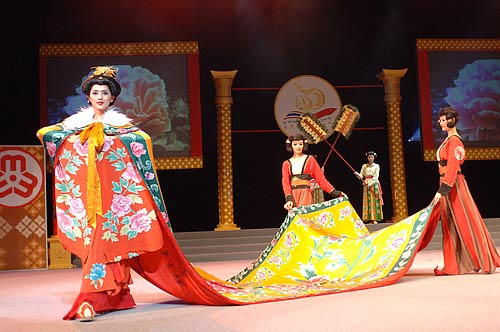| Tools: Save | Print | E-mail | Most Read |
| Chinese National Costumes |
| Adjust font size: |
Almost on the day when costumes appeared, people had integrated into costumes their social status, customs, aesthetic interests and all kinds of cultural notions. The appearances of costumes are the most direct and realistic reflection of styles and features of social history. From this sense, the history of costumes is also a vivid civilization development history.
Traditional Costumes of Tang Dynasty (618-907 AD) In Time: 20:00, November 7 20:00, November 8
Place: ARTSCAPE Theatre Center, Program: The First Act: Chinese Traditional Costumes of Past Dynasties Spring and Autumn and the Warring States Periods(770-221BC) Qin Dynasty(221 BC -206 BC) HanDynasty (206BC Tang Dynasty ( Song Dynasty ( Ming Dynasty( Qing Dynasty( The Second Act : Costumes of Minority Groups of Costumes of the Tibetan ethnic group Costumes of the Mongolian ethnic group Costumes of the Yi ethnic group Costumes of the Dai ethnic group Costumes of the Miao ethnic group The Third Act : Chinese Qipao Dress (Cheongsam) Chinese Traditional Costumes of Past Dynasties China, known as a "land of dresses",has a long history in the development of its clothing culture. Dresses in different periods reflect, to a certain extent, the situation of the politics, economy, military affairs, religions, and the civil customs of the specific historical stages. In the primitive society, people led a simple life in caves and generally worn nothing. In the Neolithic Age, the ancestors of the Chinese people were able to make tools. They invented bone needles and sewed primitive cloths. About 5,000 years ago, during the Yangshao Cultural Period, people lived a stable life and agriculture and textiles came into being. They raised silkworms and began to weave silk clothing which made people's clothing more perfect. After human kind entered the class society, clothing became the symbol of people's social statuses. During the Western Zhou Dynasty (1066-771BC), Chinese clothing in the past dynasties can be roughly divided into the following categories: clothing of the remote times; that of the Shang and Zhou Dynasties; that of the Qin and Han Dynasties; that of the Wei, Jin, and Northern and Southern Dynasties; that of the Sui,Tang, and the Five Dynasties; that of the Song Dynasty; that of the Liao, Jin, and Yuan Dynasties; that of the Ming Dynasty; that of the Qing Dynasty; and that of modern times. Costumes of Ethnic Minority Groups of As a result, the dresses of various ethic groups, like their culture, share something in common while they have their own ethnic, regional, and traditional features as well as traces of merge and transformation, forming a brilliant feature, colorful clothing culture of the Chinese. Roughly speaking, the loose gown and long robe worn by the people of the minority tribes in northern Chinese Qipao Dress (Cheongsam) The Qipao dress dates back to the Ming and Qing Dynasties. Perfectly fitting the beautiful figure of Asia females, it is regarded as quintessence of Brief Introduction of New Silk Road Co., Ltd New Silk Road Co., Ltd. is a leading models company in Organizers: The State Council Information Office of the People's Republic of Department of Arts & Culture of the Embassy of the People's Republic of (china.org.cn October 29, 2006)
|
| Tools: Save | Print | E-mail | Most Read |
 |
| Related Stories |
